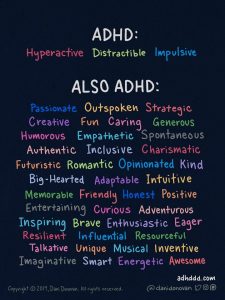 Kids with ADHD have powerful engines, but have difficulty putting on the brakes and shifting gears. There may be challenges with distractibility, impulsivity, hyperactivity and difficulty disengaging from enjoyable activities. While it is considered it a disability associated with genetic factors, it can change over the course of time as kids mature or are able to compensate for it using skills that many people use to manage their time. Kids with ADHD have other personality traits that are strengths to be recognized and used.
Kids with ADHD have powerful engines, but have difficulty putting on the brakes and shifting gears. There may be challenges with distractibility, impulsivity, hyperactivity and difficulty disengaging from enjoyable activities. While it is considered it a disability associated with genetic factors, it can change over the course of time as kids mature or are able to compensate for it using skills that many people use to manage their time. Kids with ADHD have other personality traits that are strengths to be recognized and used.
Here are some starting points for intervention, though a thorough treatment plan and medication consult often need to be implemented.
Target Behaviors
- List target behaviors that would be positive at home and school. For older children, get their ideas. You can negotiate with kids to teach problem-solving and relational skills. Do not address too much at one time. Start with one to three goals.
- This behavior will need to be prompted with a cueing system, especially expectations that are “out of sight, out of mind.”
- Reinforcements can help train the brain to focus, creating tokens that can be exchanged or lost for privileges. Create an ability to earn back losses. Later, more traditional “work before play” strategies can be used.
- List the negative triggers that lead to off task behavior.
- Address sleep hygiene.
Reinforcers:
- Use lots of social reinforcers, including positive parent and teacher attention that is communicated in a variety of ways, including verbal and written mini-celebrations of progress communicated to both student and teacher. Think of some ways this can be expressed to your child.
- Think of rewarding activities in the classroom and home that would be desirable. Tokens or points can be used to earn special privileges, even for outside of class like a complete or partial homework pass.
- Think of material reinforcers like stickers and prizes.
- Use time-in and time-out. Time-in is used for one on one attention and calming, while time-out reduces sensory inputs for a time. Even a short time-out with a fidget may help.
Practice:
- Practice desired behaviors before they come into play, just like sports teams practice before the game.
- Prompt the behaviors before they are needed. Signals other than words, or code words can be used.
- Post the expectations with pictures or words at the points where they are needed. Have the student write or draw appropriate and inappropriate behavior to be used as pictorial cues.
- Allow privileges to be used after practicing the behavior.
Remember:
- Closely follow daily routines and include time for physical release of energy.
- Prepare for transitions and less structured times. Use relaxation or imagery to help move back to structured times.
- Notice when your child is over-stimulated and intervene sooner.
- Stay calm and non-emotional, or disengage until a later time.
- Use physical proximity, have the child find your eyes, then use short sentences, telling what to do, not what not to do. Repeat, do not discuss. Be wary of multi-step directions. Check for understanding.
- Deliver consequences with less talk as possible.
- Verbal and written communication between teachers and parents.
Consider:
- A chart with pictures that the child drew that shows daily routines with which the child normally has difficulty. As the child completes each task, he or she can move a clothespin to the next picture. A checklist could also be used.
- Visual and auditory timers, like the Time Timer or from an app.
- The child can practice sustaining attention through the use of random sounds or beeps to remind child to pay attention during a task. Progress can be noted by tallying on task behavior when a beep is heard.
- Reduce distractions.
- Build in plenty of breaks to move around.
- Background music or noise which help block auditory distractions, or headphones.
- Small textured objects to manipulate or seat cushions, like Movin’ Sit Jr. or Disc O’Sit Jr.
- Apps like Inspiration and Epic Win to help kids organize, focus, and complete tasks.
- Parenting Tips
For more information on ADHD, try The ADHD Book of Lists: A Practical Guide to Helping Children and Teens with Attention Deficit Disorders by Smart But Scattered: The Revolutionary “Executive Skills” Approach to Helping Kids Reach Their Potential by Dawson & Guare , or A Family-School Intervention by T. Power, J. L. Karutis and D. F. Habbouche. More online resources include ParentsMedGuide.org, and Children and Adults with Attention-Deficit/Hyperactivity Disorder. Helpful books that relate to social skills can be found at TheGrayCenter.org or Socialthinking.com.



